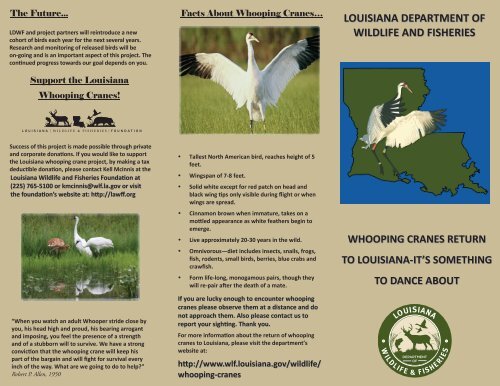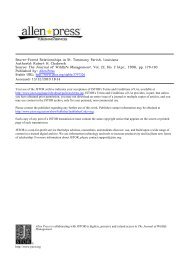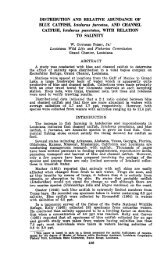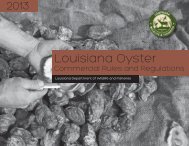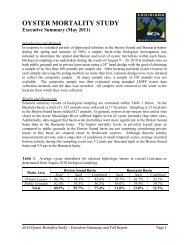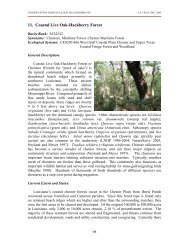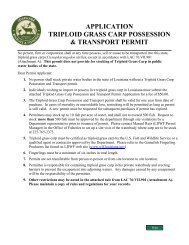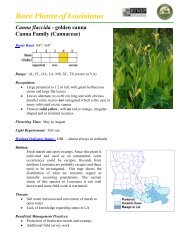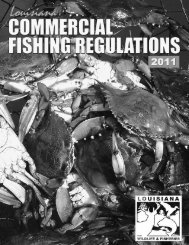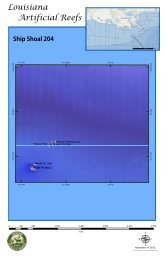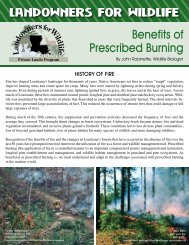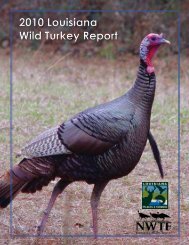Whooping Crane Brochure - Louisiana Department of Wildlife and ...
Whooping Crane Brochure - Louisiana Department of Wildlife and ...
Whooping Crane Brochure - Louisiana Department of Wildlife and ...
Create successful ePaper yourself
Turn your PDF publications into a flip-book with our unique Google optimized e-Paper software.
The Future...<br />
LDWF <strong>and</strong> project partners will reintroduce a new<br />
cohort <strong>of</strong> birds each year for the next several years.<br />
Research <strong>and</strong> monitoring <strong>of</strong> released birds will be<br />
on-going <strong>and</strong> is an important aspect <strong>of</strong> this project. The<br />
continued progress towards our goal depends on you.<br />
Support the <strong>Louisiana</strong><br />
<strong>Whooping</strong> <strong>Crane</strong>s!<br />
Facts About <strong>Whooping</strong> <strong>Crane</strong>s…<br />
LOUISIANA DEPARTMENT OF<br />
WILDLIFE AND FISHERIES<br />
Success <strong>of</strong> this project is made possible through private<br />
<strong>and</strong> corporate donations. If you would like to support<br />
the <strong>Louisiana</strong> whooping crane project, by making a tax<br />
deductible donation, please contact Kell McInnis at the<br />
<strong>Louisiana</strong> <strong>Wildlife</strong> <strong>and</strong> Fisheries Foundation at<br />
(225) 765-5100 or kmcinnis@wlf.la.gov or visit<br />
the foundation’s website at: http://lawff.org<br />
“When you watch an adult Whooper stride close by<br />
you, his head high <strong>and</strong> proud, his bearing arrogant<br />
<strong>and</strong> imposing, you feel the presence <strong>of</strong> a strength<br />
<strong>and</strong> <strong>of</strong> a stubborn will to survive. We have a strong<br />
conviction that the whooping crane will keep his<br />
part <strong>of</strong> the bargain <strong>and</strong> will fight for survival every<br />
inch <strong>of</strong> the way. What are we going to do to help?”<br />
Robert P. Allen, 1950<br />
• Tallest North American bird, reaches height <strong>of</strong> 5<br />
feet.<br />
• Wingspan <strong>of</strong> 7-8 feet.<br />
• Solid white except for red patch on head <strong>and</strong><br />
black wing tips only visible during flight or when<br />
wings are spread.<br />
• Cinnamon brown when immature, takes on a<br />
mottled appearance as white feathers begin to<br />
emerge.<br />
• Live approximately 20-30 years in the wild.<br />
• Omnivorous—diet includes insects, snails, frogs,<br />
fish, rodents, small birds, berries, blue crabs <strong>and</strong><br />
crawfish.<br />
• Form life-long, monogamous pairs, though they<br />
will re-pair after the death <strong>of</strong> a mate.<br />
If you are lucky enough to encounter whooping<br />
cranes please observe them at a distance <strong>and</strong> do<br />
not approach them. Also please contact us to<br />
report your sighting. Thank you.<br />
For more information about the return <strong>of</strong> whooping<br />
cranes to <strong>Louisiana</strong>, please visit the department’s<br />
website at:<br />
http://www.wlf.louisiana.gov/wildlife/<br />
whooping-cranes<br />
WHOOPING CRANES RETURN<br />
TO LOUISIANA-IT’S IT’S SOMETHING<br />
TO DANCE ABOUT
The Past… <strong>Louisiana</strong> Was<br />
Once Home<br />
Historically, whooping cranes occurred in <strong>Louisiana</strong> in<br />
both a resident, non-migratory flock as well as<br />
migratory birds that wintered in the state.<br />
Conversion <strong>of</strong> prairies to mechanized agriculture <strong>and</strong><br />
unregulated hunng lead to the decline <strong>of</strong> this<br />
species both naonally <strong>and</strong> at the state level. By<br />
1945, only 2 cranes remained in <strong>Louisiana</strong>. In March<br />
<strong>of</strong> 1950, the<br />
lone <strong>Louisiana</strong><br />
crane referred<br />
to as “Mac”<br />
was captured<br />
at White Lake<br />
<strong>and</strong> transported<br />
to Aransas<br />
Naonal <strong>Wildlife</strong><br />
Refuge on<br />
the central<br />
Texas coast.<br />
For sixty years<br />
whooping cranes were absent from the <strong>Louisiana</strong><br />
l<strong>and</strong>scape unl their reintroducon at the White Lake<br />
Wetl<strong>and</strong>s Conservaon Area (WLWCA) located in<br />
Vermilion Parish in 2011.<br />
History <strong>of</strong> <strong>Whooping</strong> <strong>Crane</strong>s In<br />
<strong>Louisiana</strong><br />
• 1890’s. Records indicate “large numbers” <strong>of</strong><br />
both whooping cranes <strong>and</strong> s<strong>and</strong>hill cranes on<br />
wet prairies year-round; whooping cranes also<br />
used coastal locaons in winter.<br />
• 1918. 12 whooping cranes shot north <strong>of</strong> Sweet<br />
Lake. Last <strong>of</strong>ficial record <strong>of</strong> whooping cranes on<br />
the <strong>Louisiana</strong> prairies.<br />
• Late 1930’s-early 1940’s. Last records <strong>of</strong><br />
wintering whooping cranes on southwest<br />
<strong>Louisiana</strong>’s chenier ridges <strong>and</strong> in brackish <strong>and</strong><br />
saltwater marshes near the coast.<br />
• May 1939. Biologist John J. Lynch sights 13<br />
whooping cranes north <strong>of</strong> White Lake. Two <strong>of</strong><br />
the cranes are “young-<strong>of</strong>-the-year.” This<br />
record confirms a resident flock <strong>of</strong> breeding<br />
whooping cranes in <strong>Louisiana</strong>. This is the last<br />
record <strong>of</strong> the species breeding in the wild in<br />
the United States prior to experimental <strong>and</strong><br />
capve-raised whooping cranes hatching<br />
chicks in the wild.<br />
• August 1940. Hurricane <strong>and</strong> flooding from<br />
associated rainfall scaers the resident White<br />
Lake whooping cranes. Only 6 cranes return.<br />
• 1941-1945. White Lake whooping crane flock<br />
loses 1 bird each year...only 2 cranes remain<br />
in 1945.<br />
• 1947. Only 1 whooping crane remains at<br />
White Lake.<br />
• March 1950. John J. Lynch <strong>and</strong> others capture<br />
the lone White Lake crane <strong>and</strong> relocate her to<br />
Aransas NWR, TX.<br />
Based on <strong>Louisiana</strong> whooping crane chronology compiled by<br />
Dr. Gay Gomez, McNeese State University<br />
The Present…Returning Home<br />
Starng in February 2011, the <strong>Louisiana</strong> <strong>Department</strong> <strong>of</strong><br />
<strong>Wildlife</strong> <strong>and</strong> Fisheries (LDWF) reintroduced whooping<br />
cranes back into the state at the WLWCA.<br />
The goal <strong>of</strong> the <strong>Louisiana</strong> project is to establish a selfsustaining<br />
whooping crane populaon on <strong>and</strong> around<br />
WLWCA. A self-sustaining populaon is defined as a<br />
flock with 130 individuals <strong>and</strong> 30 nesng pairs that<br />
survive for 10 years without any addional restocking.<br />
<strong>Whooping</strong> cranes that are returned to <strong>Louisiana</strong> will<br />
be a non-migratory populaon. This means the birds<br />
will be residents <strong>of</strong> <strong>Louisiana</strong> year-round.<br />
The <strong>Louisiana</strong> whooping crane populaon is<br />
designated as a Non-Essenal Experimental<br />
Populaon (NEP). This designaon is made possible<br />
by provisions contained within secon 10(j) <strong>of</strong> the<br />
Endangered Species Act, as amended. This<br />
designaon protects this whooping crane populaon<br />
as appropriate to conserve the populaon, while sll<br />
allowing the presence <strong>of</strong> the cranes to be compable<br />
with roune human acvies in the reintroducon<br />
area. Despite being an NEP species, it is illegal to<br />
shoot whooping cranes. <strong>Whooping</strong> cranes are<br />
protected under applicable state laws for non-game<br />
species <strong>and</strong> the federal Migratory Bird Treaty Act,<br />
which protects all birds that migrate such as herons,<br />
egrets, <strong>and</strong> songbirds.


